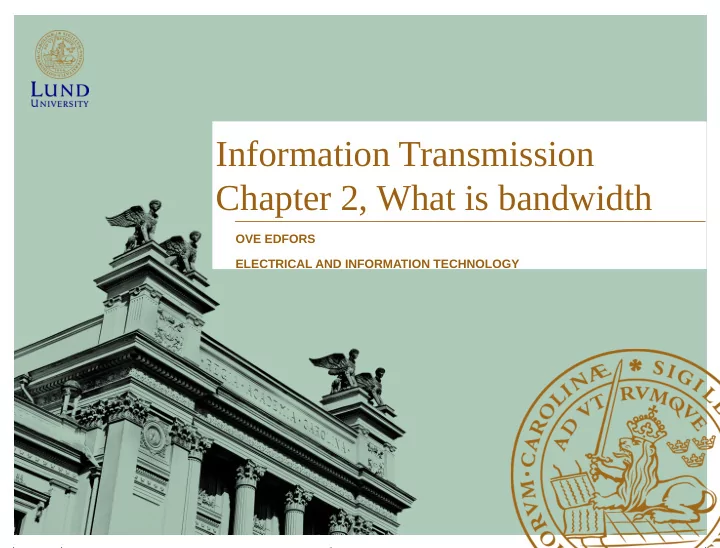

Information Transmission Chapter 2, What is bandwidth OVE EDFORS ELECTRICAL AND INFORMATION TECHNOLOGY
Learning outcomes Afther this lecture, the student should ● understand the basic principles of sampling, including – the concept of orthogonal basis functions, – the sampling theorem, – Nyquist rates/frequencies and Shannon bandwidths, and – be able to perform calculations on necessary sampling rates – based on the characteristics of the sampled signals. 2
“Certain factors affecting telegraph speed”, H. Nyquist, The Bell System Technical Journal (Volume:3 , Issue: 2 ), 1924 “This paper considers two fundamental factors entering into the maximum speed of transmission of intelligence by telegraph. These factors are signal shaping and choice of codes. The first is concerned with the best wave shape to be impressed on the transmitting medium so as to permit of greater speed without undue interference either in the circuit under consideration or in those adjacent….” 3
An introductory example Assume Combining with the time scaling property, yields What is the bandwidth of the signal? 4
What is the bandwidth of a rect pulse? The spectrum is not confined to a finite band 5
Bandwidth of a signal A softer restriction of bandwidth, that works for all signals, is that the signal x(t) has a certain fraction of its energy inside the frequency band [- W , W ], i.e. With this it seems reasonable to say that the signal has a Fourier bandwidth of W = 1/T Hz. To be more precise, we could say that the “90%-energy Fourier bandwidth'' of the signal is W = 1/T Hz, but we will usually not have need for such precision. 6
WLAN - IEEE 802.11 spectrum mask 802.11b 802.11a Source: http://www.rfcafe.com/references/electrical/wlan-masks.htm 7
The sampling theorem
“Certain Topics in Telegraph Transmission Theory”, H. Nyquist, Transactions of the American Institute of Electrical Engineers (Volume:47 , Issue: 2 ), 1928 “The most obvious method for determining the distortion of telegraph signals is to calculate the transients of the telegraph system... The present paper attacks the same problem from the alternative standpoint…This method of treatment necessitates expressing the criteria of distortionless transmission in terms of the steady-state characteristics. Accordingly, a considerable portion of the paper describes and illustrates a method for making this translation. A discussion is given of the minimum frequency range required for transmission at a given speed of signaling….” 9
Basis functions for sampling Consider the function with Fourier transform is confined to the frequency band [ -W,W ]. 10
Orthonormal functions Versions of delayed by , where k is an integer, form a set of orthonormal functions . The term orthonormal means that the functions are orthogonal and normalized . 11
Orthogonal functions Orthogonality is an important notion in signal analysis. it means that where is the energy of 12
Orthogonality of the basis functions , where k is an integer, are orthogonal functions since What does this mean? 13
Normalized functions Furthermore, since for all k , these functions are normalized (energy ). A set of orthogonal and normalized functions is called an orthonormal set of functions . 14
The sampling theorem If x(t) is a signal whose Fourier transform is identically zero for , then x(t) is completely determined by its samples taken every seconds in the manner See the book for a proof 15
Nyquist rate/Nyquist frequency The sample points are taken at the rate 2W samples per second. If W is the smallest frequency such that the Fourier transform of x(t) is identically zero for then the sampling rate 2W is called the Nyquist rate or Nyquist frequency. 16
Shannon bandwidth Let denote the smallest such that is orthogonal to every time-shift of itself by a nonzero multiple of We call the Nyquist-shift of the basis signal The Nyquist-shift of the signal is The Shannon bandwidth B of the basis signal is or equivalently basis functions per second 17
The fundamental theorem of bandwidth The Shannon bandwidth B of a basis signal is at most equal to its Fourier bandwidth W ; equality holds when the signal is a sinc function. The Shannon bandwidth can be thought of as the amount of bandwidth a signal needs and the Fourier bandwidth as the amount of bandwidth a signal uses . 18
Summary Under certain conditions, ”arbitrary” continuous-time signals can be ● perfectly described by discrete samples. Orthogonal basis functions are an important tool for translating between ● continuous-time sigbals and their disctrete-time sampled equivalents. According to the sampling theorem, a real time-continuous signal without ● frequency components from W Hz and above, can be perfectly represented by samples taken at a rate 2 W samples/sec, or 2 W Hz. This sampling rate (frequency) is called the Nyquist rate or Nyquist frequency . A signal with highest frequency component at W Hz (Nyquist bandwidth ● W) may have a characteristic that allows it to be represented by fewer samples than what is given by the Nyquist sampling rate. This is characterized by the Shannon bandwidth, which is then said to be smaller than the Nyquist bandwidth. 19
Recommend
More recommend